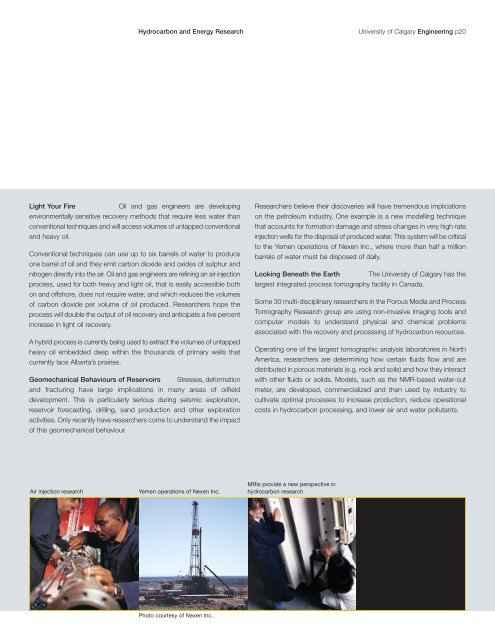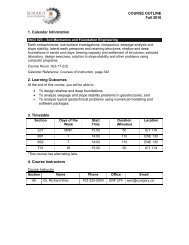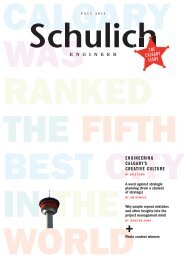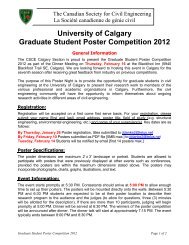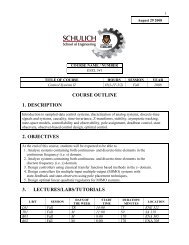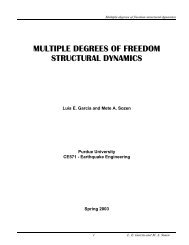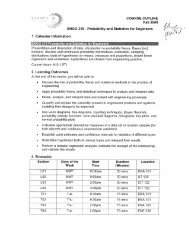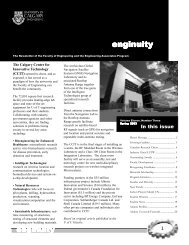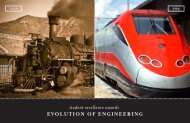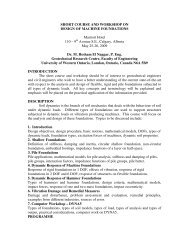Moving Society Ahead, Together - The Schulich School of ...
Moving Society Ahead, Together - The Schulich School of ...
Moving Society Ahead, Together - The Schulich School of ...
You also want an ePaper? Increase the reach of your titles
YUMPU automatically turns print PDFs into web optimized ePapers that Google loves.
Hydrocarbon and Energy Research<br />
University <strong>of</strong> Calgary Engineering p20<br />
Light Your Fire<br />
Oil and gas engineers are developing<br />
environmentally sensitive recovery methods that require less water than<br />
conventional techniques and will access volumes <strong>of</strong> untapped conventional<br />
and heavy oil.<br />
Conventional techniques can use up to six barrels <strong>of</strong> water to produce<br />
one barrel <strong>of</strong> oil and they emit carbon dioxide and oxides <strong>of</strong> sulphur and<br />
nitrogen directly into the air. Oil and gas engineers are refining an air injection<br />
process, used for both heavy and light oil, that is easily accessible both<br />
on and <strong>of</strong>fshore, does not require water, and which reduces the volumes<br />
<strong>of</strong> carbon dioxide per volume <strong>of</strong> oil produced. Researchers hope the<br />
process will double the output <strong>of</strong> oil recovery and anticipate a five percent<br />
increase in light oil recovery.<br />
A hybrid process is currently being used to extract the volumes <strong>of</strong> untapped<br />
heavy oil embedded deep within the thousands <strong>of</strong> primary wells that<br />
currently lace Alberta’s prairies.<br />
Geomechanical Behaviours <strong>of</strong> Reservoirs Stresses, deformation<br />
and fracturing have large implications in many areas <strong>of</strong> oilfield<br />
development. This is particularly serious during seismic exploration,<br />
reservoir forecasting, drilling, sand production and other exploration<br />
activities. Only recently have researchers come to understand the impact<br />
<strong>of</strong> this geomechanical behaviour.<br />
Researchers believe their discoveries will have tremendous implications<br />
on the petroleum industry. One example is a new modelling technique<br />
that accounts for formation damage and stress changes in very high rate<br />
injection wells for the disposal <strong>of</strong> produced water. This system will be critical<br />
to the Yemen operations <strong>of</strong> Nexen Inc., where more than half a million<br />
barrels <strong>of</strong> water must be disposed <strong>of</strong> daily.<br />
Looking Beneath the Earth <strong>The</strong> University <strong>of</strong> Calgary has the<br />
largest integrated process tomography facility in Canada.<br />
Some 30 multi-disciplinary researchers in the Porous Media and Process<br />
Tomography Research group are using non-invasive imaging tools and<br />
computer models to understand physical and chemical problems<br />
associated with the recovery and processing <strong>of</strong> hydrocarbon resources.<br />
Operating one <strong>of</strong> the largest tomographic analysis laboratories in North<br />
America, researchers are determining how certain fluids flow and are<br />
distributed in porous materials (e.g. rock and soils) and how they interact<br />
with other fluids or solids. Models, such as the NMR-based water-cut<br />
meter, are developed, commercialized and then used by industry to<br />
cultivate optimal processes to increase production, reduce operational<br />
costs in hydrocarbon processing, and lower air and water pollutants.<br />
Air injection research<br />
Yemen operations <strong>of</strong> Nexen Inc.<br />
MRIs provide a new perspective in<br />
hydrocarbon research<br />
Photo courtesy <strong>of</strong> Nexen Inc.


